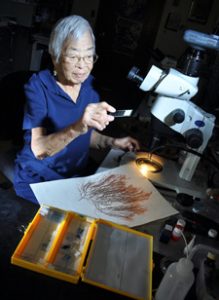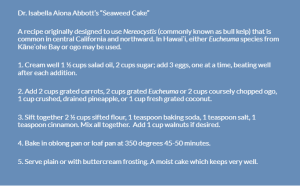
(Stanford Magazine)
Isabella Kauakea Yau Yung Aiona, born on June 20th, 1919, in Hāna, Maui, spent much of her childhood at the seashore learning about the edible seaweeds of Native Hawaii from her mother. Together, they would collect them, and use the seaweed to cook traditional Hawaiian meals. These memories sparked her passion in this fascinating and important organism. It was this passion that led to Dr. Abbott being the world’s foremost expert in the Ethnobotanical study of Hawaiian Seaweeds and an heroic, groundbreaking female scientist.
“When you’re looking for seaweeds, you’re not drowning or doing crazy things in the water, so my parents were happy to take us to the beach,” she recalls. Her mother knew the Hawaiian names of almost all the edible species. Those she didn’t know, she called ʻōpala (rubbish). “Hawaiians ate seaweed raw. It was cleaned and pounded and salt added as a preservative,” says Abbott. “It was massaged to release the flavors. That’s where you get lomi salmon. Many older Hawaiians, myself included, eat limu (seaweed) by itself because we like it. It has vitamins and minerals. Today, people think all limu taste alike, or yuck. We’ve moved to a cuisine that uses it more as a pickle.”
Abbott graduated from a private high school for Hawaiian students in 1937. She began her undergraduate degree at University of Hawai‛i at Mānoa, where she studied botany. There, she met her future husband, Don, who was also interested in marine sciences. After graduating together in 1941 and marrying in 1943, the two supported each other through master’s degrees and receiving doctorates from the University of California, Berkley; Don Abbott in zoology and Isabella Abbott in algal taxonomy in 1950. Dr. Isabella Abbott was the first Native Hawaiian woman to earn a doctoral degree in a scientific field.
Like most female PhDs at the time, it was difficult to find a job in academia, so it was no surprise that, despite having the same credentials, her husband received 6 job offers, and Isabella received 0. The couple stayed in California so Isabella’s husband could work for the next 10 years at Stanford’s Hopkins Marine Station in Pacific Grove. There, she refined her seaweed culinary skills while raising their daughter. In 1960, she was offered a lecturer position at Hopkins Marine Station teaching students how to identify various marine plant species. She co-published the book Marine Algae of California, Which included her own research, even 55 new species and an entirely new genus of red algae her co-author named after her. She became the first person of color to receive full professorship at Stanford University and the first female professor in the Biology department in 1972. During her tenure, she battled breast cancer, mentored numerous young marine scientists, and identified 200 new algal species.
Dr. Abbott realized that Native Hawaiians were keen naturalists, understanding marine plants intimately. She began interviewing kūpuna (Hawaiian for elders) to document their rich ecological knowledge. In one interview, Dr. Abbott explained that this documentation is necessary “so that Hawaiians are not put in second or third-class status of Native people who don’t know anything. Hawaiian culture is unbelievably sophisticated.” Documenting oral histories helped her discover historical uses for native plants and how they can be used today, as well as traditional Hawaiian methods for the cultivation and harvest of limu. The results of her work resulted in two popular books, Limu: An Ethnobotanical Study of Some Hawaiian Seaweeds in 1974 and La’au Hawai’i: Traditional Hawaiian Uses of Plants in 1992.
The Abbotts retired to Hawai’i in 1982, though, this “retirement,” did not last long. Dr. Abbott began what she called her second career, teaching traditional Hawaiian usage of plants at University of Hawai‛i at Mānoa where she continued working until her passing in 2010. Her hands-on ethnobotany classes were so successful that they led to the development of an undergraduate degree in the subject.

Dr. Abbott’s Seaweed Cake recipe
Resources
Dr. Isabella Abbott: First lady of Limu: About the hero. Lowell Milken Center. (2023, February 13). https://www.lowellmilkencenter.org/programs/projects/view/dr-isabella-abbott-first-lady-of-limu/hero
Ethogram, P. by T. (2021, October 6). Science heroes: Dr. Isabella Aiona abbott. theethogram.com. https://theethogram.com/2021/06/29/science-heroes-dr-isabella-aiona-abbott/
Marine botanist Isabella Aiona abbott and more women to know this Asian American and Pacific Islander Heritage month. Smithsonian American Women’s History. (2021, May 3). https://womenshistory.si.edu/stories/marine-botanist-isabella-aiona-abbott-and-more-women-know-asian-american-and-pacific-islander
Pioneering professor is first lady of Limu: Malamalama, the magazine of the University of Hawai’i System. Pioneering Professor is First Lady of Limu | Malamalama, The Magazine of the University of Hawai’i System. (n.d.). http://www.hawaii.edu/malamalama/2010/10/isabella-abbott/
University, S. (2022, May 31). Trailblazing marine botanist Isabella Abbott honored. Stanford Report. https://news.stanford.edu/report/2022/05/26/trailblazing-marine-botanist-isabella-abbott-honored/